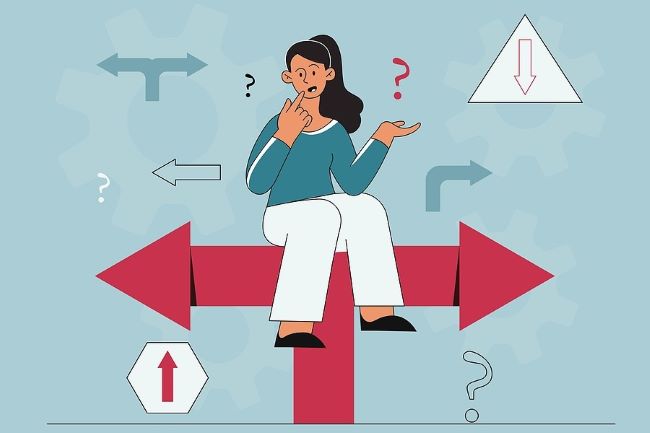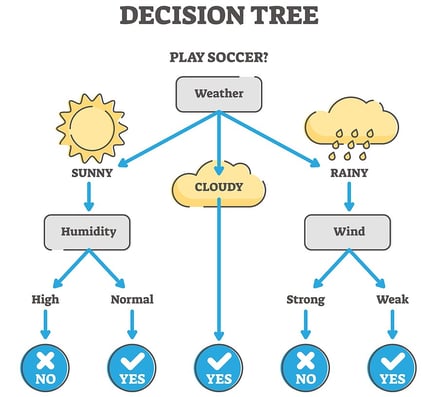How and When to Use a Decision Tree in Your Marketing Mix

Planning your insurance marketing funnel? Be sure to consider a decision tree. A decision tree is a flow chart that guides decision making. The options branch into different paths, allowing users to see the possible outcomes of their decisions.
Decision trees have been around for some time. A Harvard Business Review article published in July 1964 shows how decision trees can guide various decisions, ranging from whether a company should build a large or small manufacturing plant to whether a host should hold a cocktail party indoors or outdoors.
In some cases – like the examples in the Harvard Business Review article – the different branches represent circumstances that are unknown and outside of the decision-maker’s control; for example, whether it will rain on the night of a cocktail party. These decision trees help people consider best-case and worst-case scenarios to plan accordingly.
In other cases, the different branches represent conditions the decision-maker can determine with certainty. These decision trees often operate on a yes/no basis. By answering “yes” or “no” to a series of questions, decision-makers can arrive at conclusions that match their situations. This type of decision tree can be ideal in marketing. See the very simple example below.

Decision Trees Provide Guidance in a DIY Culture
The internet has given rise to a DIY culture. Many people would rather conduct their own research and figure things out for themselves than have someone spoon feed them information.
Sometimes, this comes down to distrust. People know companies are trying to sell them something and are wary of misleading advertisements and pushy salespeople. They want to decide themselves what’s right for them.
Let’s say you have a prospect who’s interested in your services. You have three different packages that the prospect can choose from. One is a basic package that has a lower price point. One is a premium package, which is more expensive. There’s also a midrange package.
You know your product well and are confident the premium package is the right one for this prospect. If the prospect chooses the basic package, he or she will probably be frustrated when it doesn’t meet their needs. You suggest the premium package. Unfortunately, the prospect thinks you’re just trying to push a more expensive service and resists.
If you used a decision tree, this could go differently. Instead of telling prospects they need to spend more on the premium package, you let them figure this out for themselves. As they make the decision independently, they’re confident in the result. They buy the premium package and become satisfied customers.
How to Add Decision Trees to Your Content Marketing Strategy
The best time to use a decision tree in your content marketing strategy is when the prospect is ready to make a decision. This happens at the bottom of the funnel.
- At the top of the funnel, prospects are just learning about your company. They’re conducting research, but they’re not ready to buy yet. At this stage, it’s better to provide ungated content that focuses on prospects’ problems and concerns, not on your products or services.
- In the middle of the funnel, prospects are familiar with your company, and you’re nurturing the relationship. However, prospects still aren’t ready to make a decision. This is a good time to provide more in-depth content, including some gated content.
- At the bottom of the funnel, prospects are getting ready to make a decision. This is when you need to show that your product or service is the best match for their needs. A decision tree can help at this stage.
Creating Your Decision Tree
A standard decision tree uses a branching structure that guides users toward a conclusion. However, you should feel free to mix things up. For example, you might decide to create an infographic that uses yes/no questions but that doesn’t stick to the traditional branching structure of a decision tree. (The Content Road Map is an example of this.) That’s fine! What’s important is that you’re guiding your prospects through the decision-making process in a way that makes sense for your products.
Add Decision Trees to Your Content Marketing Strategy
An effective content marketing strategy requires multiple types of content that appeal to prospects at different stages of the buyer’s journey. In addition to a decision tree, you may need blog posts, white papers, case studies, infographics, and checklists. Inbound Insurance Marketing can provide everything you need as part of a content package that’s customized to meet your needs. We provide copywriting and graphic design services, tailored for the insurance industry.
Not sure what type of content you need? Use the Content Road Map.
